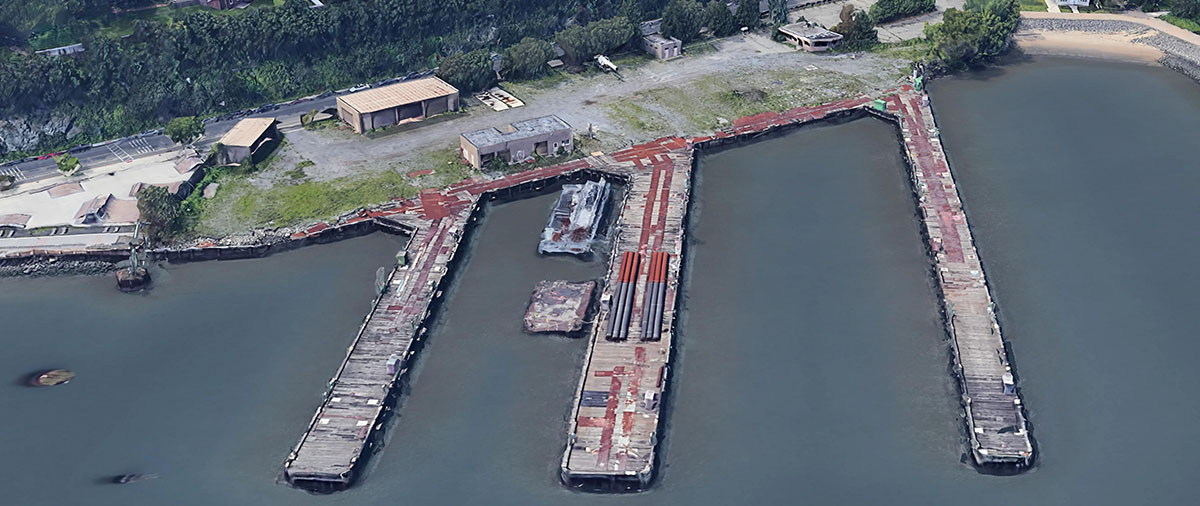The Public Trust Doctrine provides the legal grounds for a public waterfront
Gap sites in the Hudson River Waterfront Walkway include Admiral’s Walk in Edgewater (slide 1), the Weehawken Park just to the north of Lincoln Harbor in Weehawken (slide 2), Union Dry Dock in Hoboken (slide 3) and Liberty Harbor North in Jersey City just north of Liberty State Park (slide 4).
FBW | March 1, 2022
As maritime industries abandoned the lower Hudson River, New Jersey policy makers conceived the idea of a public walkway stretching the 18.5 miles of coastline from the Bayonne Bridge up to the George Washington Bridge. In 1988, the New Jersey Department of Environmental Protection (NJDEP) adopted Coastal Zone Management Regulations requiring developers to grant a public easement to the State and build their portion of the 30-foot wide walkway. Called the Hudson River Waterfront Walkway, today it is mostly built and accessible to the public in the eight municipalities north of Bayonne.
Except for the working waterfront that exists along the Kill Van Kull in Bayonne, there are just a few remaining gaps of the walkway to be filled. Two such gaps in the walkway are at the Monarch Pier and the Union Dry Dock site. The City of Hoboken acquired the Monarch property last November in a land-swap deal with the Shipyard Associates. Last June, Hoboken Mayor Ravi Bhalla and Governor Phil Murphy announced an agreement with NY Waterway for the City to acquire the three-acre Union Dry Dock, a former barge repair facility. Both sites will be developed as public parks that will complete the final missing links in Hoboken’s Hudson River Waterfront Walkway, finally providing the public an unobstructed public route along Hoboken’s entire 1.5 mile coastline north of the Hoboken Terminal.
Don Stitzenberg is president of the Hudson River Waterfront Conservancy, a nonprofit organization that has overseen the implementation of the walkway and works closely with the NJDEP. In a recent conversation with FBW, Mr. Stitzenberg said there are additional walkway gaps that exist in Edgewater, North Bergen, Weehawken and Jersey City. He expects in the next several years that many of these sections of the walkway will be completed.
One of the gap sites in Edgewater is located at Admiral’s Walk, a 297-unit gated community built in the 1980s prior to the adoption of New Jersey’s Coastal Zone Regulations. In March of 2020, the Hudson River Waterfront Conservancy sued the Admiral’s Walk Condominium Association for violating New Jersey’s public access requirements. The Association’s website describes a “private park-like walkway along the river” as one of its amenities. The Conservancy has been working closely with the NJDEP to reach an agreement with the condo association to get the walkway rebuilt and opened to the public.
Over the years, other disputes have arisen regarding the walkway. In 1999, the National Association of Home Builders and New Jersey Builders Association filed suit contending that the state regulations constituted a “taking” of private property. A federal judge disagreed, citing the Public Trust Doctrine. The Hudson River once encompassed these lands identified in the state regulations as the “filled water’s edge.” Originally, the State of New Jersey issued tidelands grants to maritime industries operating from the docks lining the shoreline. As private developers acquired these lands beginning in the 1970s, debates and controversies ensued concerning the public vs. private nature of the shoreline.
In the 1990s, the Shelter Bay Club Condo Association, also in Edgewater, New Jersey, built its portion of the Waterfront Walkway and granted an easement to the NJDEP. But later they fenced off the walkway, blocking public access. The NJDEP took the condo association to court. After years of litigation, the NJDEP prevailed and the court finally ordered the condo association to take down the fence.
Residential and commercial projects on Hudson River piers have sparked many conflicts. FBW has successfully defeated a series of proposals to build on Hoboken’s piers, contending that they would privatize that portion of the waterfront. The latest battle was over the Monarch Pier where the Shipyard Associates proposed two residential towers. FBW, represented by the New Jersey Appleseed Public Interest Law Center, joined the City of Hoboken in challenging this project, leading to the settlement allowing the City to acquire the site.
It has been FBW’s 30 plus years of advocacy for a continuous, public waterfront park that has facilitated the completion of the Hudson River Waterfront Walkway in Hoboken. FBW advocates for a clear delineation, via the traditional street grid, between the public waterfront park and the upland blocks for private development. As a result, conflicts between public and private uses have been averted.
The nine other municipalities have essentially abdicated their planning authority at their waterfronts. The resulting lack of a public street system makes accessing the water’s edge more difficult and causes the waterfront walkway to share a boundary with private backyards. In Edgewater and Guttenberg, much of the walkway sits behind gated communities with fences, gates and guardhouses. At the Jersey City waterfront, high-rise residential towers loom over the walkway.
Between 2017 and 2020, FBW and the City of Hoboken waged a pitched battle with NY Waterway and the State of New Jersey over the Union Dry Dock site. The agreement announced last June will result in this property being one of the final segments of Hoboken’s waterfront park and add another 736 foot stretch to the Hudson River Waterfront Walkway.
Related Video
Walking the Hudson River Waterfront Walkway
Related Links
After a contentious, multi-year battle, City will acquire Union Dry Dock
Monarch settlement advances
Shipyard developers have sought to privatize an otherwise public waterfront
Shipyard’s plan to privatize pier
The privatization of part of Pier A Park’s Hudson River Waterfront Walkway
The Public Trust Doctrine
Walking the public walk along the dramatically transformed Bayonne waterfront
A Plan for the Hoboken Waterfront





